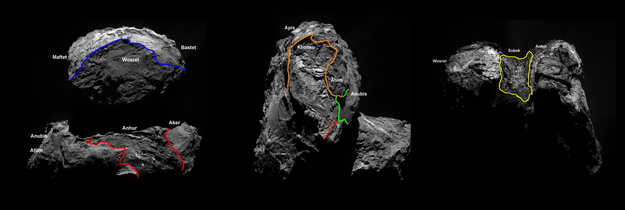Comet 67P/C-G's southern hemisphere

Date: 13 August 2015
Satellite: Rosetta
Depicts: Comet 67P/Churyumov-Gerasimenko
Copyright: See below
Four new regions, separated by distinct geomorphological boundaries, have been identified on the southern hemisphere of Comet 67P/Churyumov-Gerasimenko.
The complex season cycle on the comet means the southern hemisphere – which includes part of both comet lobes – had been undergoing winter for over five years. Around May 2015, seasons on the comet changed, throwing the southern hemisphere into a short – approximately 10 month – summer and revealing parts of the surface that were previously cast in shadow.
This allowed scientists to fill in some of the missing pieces of the comet's regional map. Like the 19 regions that had been identified in January 2015, the four new ones are named for Egyptian deities, following the ancient Egyptian theme of the Rosetta mission: Anhur, Khonsu, Sobek and Wosret. Anhur and Khonsu can be found on the underside of the comet's larger lobe, Wosret on the smaller lobe, and Sobek is located on the comet's neck.
Credit: ESA/Rosetta/MPS for OSIRIS Team MPS/UPD/LAM/IAA/SSO/INTA/UPM/DASP/IDA
